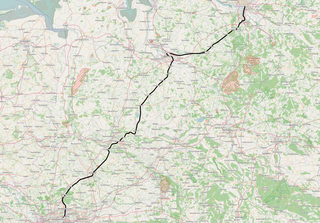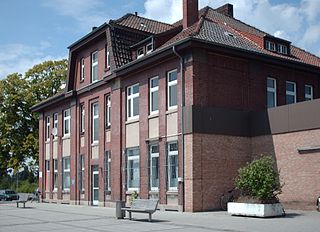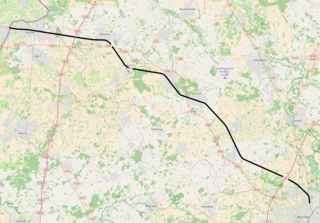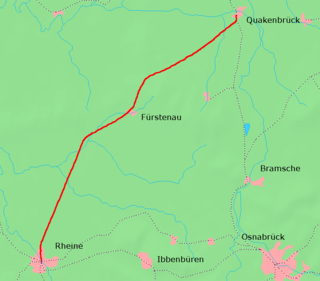
Enschede is the main railway station in Enschede, Netherlands. The station opened on 1 July 1866 and is on the Zutphen–Glanerbeek railway. Between the late 1970s and 2001, the passenger service to Germany stopped. The connection to Münster was reopened in 2001. There is no connection allowing the German trains to run any further into Overijssel; however there was before the line closed.

Münster Hauptbahnhof is the main railway station in the city of Münster in Germany.
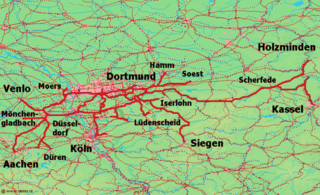
The Witten/Dortmund, Oberhausen/Duisburg railway is one of the most important railways in Germany. It is the main axis of long distance and regional rail transport on the east–west axis of the Ruhr and is served by Intercity-Express, InterCity, Regional-Express, Regionalbahn and S-Bahn trains.
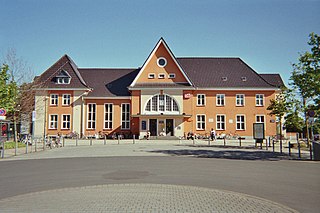
Lünen Hauptbahnhof is a railway station located north of central Lünen on the outskirts of Nordlünen in the German state of North Rhine-Westphalia.
The Zutphen–Glanerbeek railway is a railway line in the Netherlands running from Zutphen to the German border at Glanerbrug, passing through Hengelo and Enschede. It is also called the Staatslijn D in Dutch. "Glanerbeek" is the former name for the Glanerbrug railway station. The line was opened between 1865 and 1868. The section between Enschede and the German border was closed for traffic in 1981, but it was reopened in 2001, although physically disconnected from the Dutch railway network; no Dutch train can enter this stretch and trains coming from Germany can not enter the Dutch network through Enschede.
The Bochum–Essen/Oberhausen railway was built by the Bergisch-Märkische Railway Company to the north of its main line through the central Ruhr to tap traffic from mines and factories in the northern Ruhr region, which is now in the German state of North Rhine-Westphalia.

Steinfurt-Burgsteinfurt station is the main station of the town of Steinfurt in western Munsterland in the German state of North Rhine-Westphalia and is located in the district of Burgsteinfurt. The station is a former railway junction on the Münster–Enschede railway. The Coesfeld–Rheine railway and the Borken–Steinfurt railway are closed and largely dismantled.
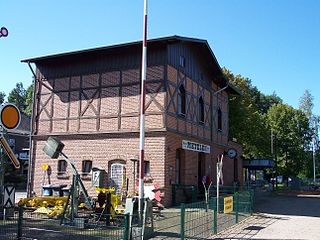
Metelen Land station is located in Metelen in the German state of North Rhine-Westphalia on the Münster–Enschede railway. The station is operated by the Metelen Land Railway Museum.
The Hellweg net consists of the four Regionalbahn lines in the German state of North Rhine-Westphalia: RB 50, RB 59, RB 69 and RB 89. It has a length of about 370 km. The RB 50 is referred to as Der Lüner, the RB 59 as Die Hellweg-Bahn and the RB 69 and RB 89 together as Die Ems-Börde-Bahn. On 14 December 2008 operations were taken over by eurobahn. Previously these four Regionalbahn services were operated by DB Regio NRW.

Epe (Westf) is a railway station in the town of Epe, North Rhine-Westphalia, Germany. The station lies on the Dortmund–Enschede railway and the train services are operated by Deutsche Bahn.
Legden is a railway station in the town of Legden, North Rhine-Westphalia, Germany. The station lies on the Dortmund–Enschede railway and the train services are operated by Deutsche Bahn.
Rosendahl-Holtwick is a railway station in the town of Rosendahl, North Rhine-Westphalia, Germany. The station lies on the Dortmund–Enschede railway and the train services are operated by Deutsche Bahn.
Lette is a railway station in the town of Lette, North Rhine-Westphalia, Germany. The station lies on the Dortmund–Enschede railway and the train services are operated by Deutsche Bahn.
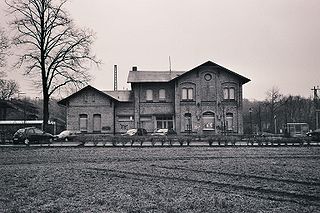
Nottuln-Appelhülsen is a station in Appelhülsen, a suburb of the municipality of Nottuln, in the district of Coesfeld in the German state of Nordrhein-Westfalen.






